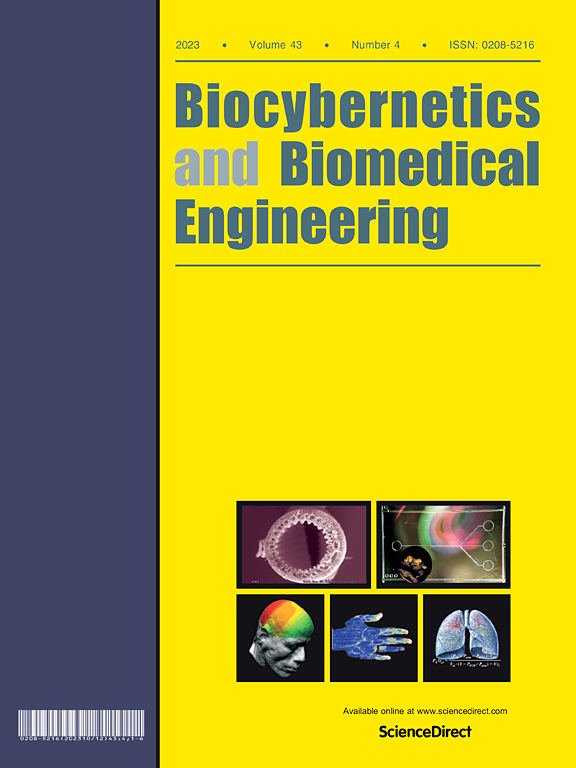Visuo-tactile stimulated virtual mirror therapy (ViTaS-VMT) system for enhancing motor-related brain activities: Application on two amputees
IF 6.6
2区 医学
Q1 ENGINEERING, BIOMEDICAL
引用次数: 0
Abstract
To enhance the degenerated brain signal of amputees on motor area, a visuo-tactile stimulated virtual mirror therapy system was developed. The system consists of a motion-tracking glove, a vibration motor, and a monitor-integrated table. The system can provide virtual hand illusion for body agency and combine visuo-tactile stimulation to induce body ownership on the virtual hand. The virtual hand then mimics the healthy hand like mirror therapy, and subjects perform grasping with both hands while observing the mirrored virtual hand on the amputated side. The training lasted three days, including the gradual exposure to the system to measure the difference in brain activity on the first day. We measured electroencephalogram (EEG) during training, and functional magnetic resonance imaging (fMRI) of grasping was measured before and after the training. Two amputees volunteered for this preliminary study. Both participants showed changes in motor-related brain activity, with consistent increases in event-related desynchronization (ERD) amplitude, particularly in the supplementary motor area (SMA) and primary motor cortex. These findings suggest the system’s potential to enhance motor-related neural processes. We believe that the results of this preliminary study have provided evidence that the proposed system can reproduce the learning process and that brain activation can be improved by using the system. Based on the results, a future study will expand the number of subjects and the duration of training to provide a quantitative clinical evaluation of the proposed system.
视觉触觉刺激虚拟镜像治疗(ViTaS-VMT)系统增强运动相关的大脑活动:在两名截肢者的应用
为了增强截肢者运动区退化的脑信号,研制了一种视触觉刺激虚拟镜像治疗系统。该系统由一个运动跟踪手套、一个振动马达和一个监视器集成表组成。该系统可以为身体代理提供虚拟手幻觉,并结合视触觉刺激诱导虚拟手上的身体所有权。然后,虚拟手模仿健康的手,就像镜子治疗一样,受试者在观察截肢一侧的镜像虚拟手的同时,用双手抓握。训练持续了三天,包括在第一天逐渐接触该系统,以测量大脑活动的差异。训练时测量脑电(EEG),训练前后测量抓握功能磁共振成像(fMRI)。两名截肢者自愿参加这项初步研究。两名参与者都表现出与运动相关的大脑活动的变化,事件相关的去同步(ERD)幅度持续增加,特别是在辅助运动区(SMA)和初级运动皮层。这些发现表明,该系统具有增强运动相关神经过程的潜力。我们认为,这项初步研究的结果已经提供了证据,表明所提出的系统可以重现学习过程,并且通过使用该系统可以改善大脑的激活。基于结果,未来的研究将扩大受试者的数量和培训时间,以提供拟议系统的定量临床评估。
本文章由计算机程序翻译,如有差异,请以英文原文为准。
求助全文
约1分钟内获得全文
求助全文
来源期刊

Biocybernetics and Biomedical Engineering
ENGINEERING, BIOMEDICAL-
CiteScore
16.50
自引率
6.20%
发文量
77
审稿时长
38 days
期刊介绍:
Biocybernetics and Biomedical Engineering is a quarterly journal, founded in 1981, devoted to publishing the results of original, innovative and creative research investigations in the field of Biocybernetics and biomedical engineering, which bridges mathematical, physical, chemical and engineering methods and technology to analyse physiological processes in living organisms as well as to develop methods, devices and systems used in biology and medicine, mainly in medical diagnosis, monitoring systems and therapy. The Journal''s mission is to advance scientific discovery into new or improved standards of care, and promotion a wide-ranging exchange between science and its application to humans.
 求助内容:
求助内容: 应助结果提醒方式:
应助结果提醒方式:


